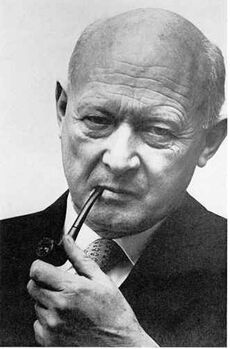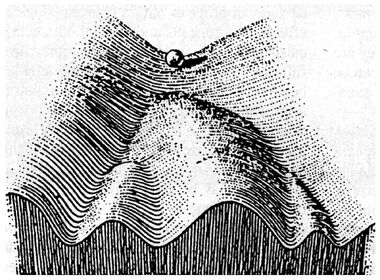
Conrad Hall Waddington was a leading embryologist from the 1930s to the 1950s. Before the Second World War, Waddington's studies focused mainly on basic embryological principals, especially on the idenification of inducing factors that are active in early embryonic development. After Second World War his interest shifted more towards genetic studies.
Biography[]
C. H.Waddington was born in 1905, in India. When he was four years old, he was brought by relatives to England, where he attended the Clifton College School. Waddington then went to the University of Cambridge and studied the natural sciences,specializing in geology. In 1929, after his PhD. studies, he obtained a research fellowship at the Strangeways Laboratory near Cambridge. In this time period he was, among many other things, also interested in German research in embryology that had led to the discovery of the ‘organizer’ by Spemann and Mangold in 1924. He build on their results and showed that there was an organizer even in mammals and birds.In higher vertebrates, the main body axis appears at an early stageas a condensation of cells called the ‘primitive streak’. At the anterior end of the streak is a region called Hensen’s node. Waddington showed that the grafting of a duck node onto an early chick embryo (at the blastoderm stage) could induce the formation of a second body axis. In 1932 he published a famous paper, in which he is showing that the organizer tissue that was killed by heating or freezing had some inducing activity and that the inducing signalwas therefore likely to be a chemical substance.
Despite his involvement in embryology, Waddington was also interested in genetics. In 1939, he went to the United States and worked on Drosophila wing development. He was interested mainly in the similarity between the decision points found in both inducing-factor action and gene action.
Epigenetics[]
Conrad Waddington is not only the founder of Epigenetics (he fused classical genetics and the epigenesis theory of Aristoteles), but also the author of the term itself. He first used this term in his textbook "Principles of Embryology", which he issued in 1942: []
„Perhaps the most satisfactory expression would be ‚epigenetics‘. This is derived from Greek word epigenesis, which Aristotle used for the theory that development is brought about through a series of causal interactions between the various parts; this also reminds one that genetic factors are among the most important determinants of development“.
Ever since the term "Epigenetics" is widely used.
Epigenetics studies heritable changes in gene expression or in the cellular phenotype, which are not cuased by changes in the DNA sequence. These changes usually involve DNA methylation and histone modification. Although these changes do not change the DNA sequence, they are still inherited in other generations.
The epigenetic landscape[]

http://jcs.biologists.org/content/116/8/1397/F6.expansion.html
The epigenetic landscape theory describes a surface, in which a ball rolls down. The Ball represents a cell in an embryo. At surface is not straight, but it has a lot of twists and branches of possible paths, which the ball can take. These branch points represent the choices of the embryo mediated by inducing factors and/or homeostatic genes. By the time the ball rolls to the bottom it will make several choices, which will form the resulting cell.
References[]
Slack J.M.W., Conrad Hal Waddington: the last Renaissance biologist? , Nature Genetics, 3:889-895 (2002)